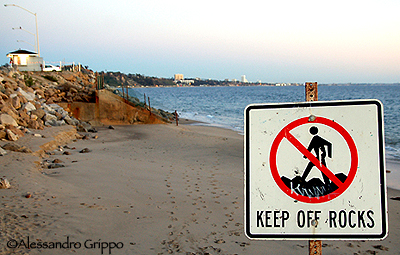 |
GEOL 31 - Physical Oceanography
Exam # 2 Study Guide - Fall 2017
exam date: Monday, October 16, 2017
Professor: Dr. Alessandro Grippo, Ph.D.
|
|
| |
| General Information | Last Updated • October 4, 2017 | |
PLEASE NOTE:

The southern California coast in Pacific Palisades, Los Angeles:
an example of a transform active margin.
| |
| Study Guide | Last Updated • October 4, 2017 | |
For a better grasp of the materials:
- Check the "essential Learning Concepts" at the beginning of each chapter
- Do the "Concept Check" section at the end of each paragraph
- Review "SmartFigures" when indicated in the textbook
- Go over the "Essential Concepts Review" section at the end of each chapter
Chapter 3 - Marine Provinces
review the Marine Provinces powerpoint
Study the whole chapter
- Know What Techniques are used to Determine Ocean Bathymetry?
- Know What Features Exist on Continental Margins?
- Know What Features Exist in the Deep-Ocean Basins?
- Know What Features Exist Along the Mid-Ocean Ridge?
- Know Earth's Hypsographic Curve (section "Diving Deeper" 3.1, page 97)
what do the flat portions and the slopes of the hypsographic curve seem to suggest?
Chapter 4 - Marine Sediments
Study the whole chapter
- Know the Introduction
- Know How Are Marine Sediments Collected, and What Historical Events Do They Reveal?
Be sure to review Table 4.1, page 106, to fully understand the distribution of sediments in the oceans.
- Know What Are the Characteristics of Lithogenous Sediment?
Be sure to study all the subparagraphs and to review Table 4.2, page 113. The names of lithogenous sediment grains, as you remember, are function of their size and not their composition. You are only required to know clay, silt, sand, and gravel.
- Know What Are the Characteristics of Biogenous Sediment?
Be sure to study all the subparagraphs.
- Know What Are the Characteristics of Hydrogenous Sediment?
Be sure to study all the subparagraphs.
- Know What Are the Characteristics of Cosmogenous Sediment?
- Know How Are Pelagic And Neritic Deposits Distributed?
Be sure to study all the subparagraphs. Pay attention to figures 4.20, page 125; 4.21, page 126
- Know What Resources Do Marine Sediments Provide?
Chapter 5 - Water and Seawater
Study the whole chapter
- Know the Introduction
- Know Why Does Water Have Such Unusual Properties?
Be sure to study all the subparagraphs. Pay attention to figures 5.2, page 138; 5.3 and 5.4, page 139
- Know What Other Important Properties Does Water Possess?
Be sure to study all the subparagraphs. Pay attention to figures 5.5 and 5.6, page 141; 5.7 and 5.8, page 142; 5.12, page 146.
- Know How Salty Is Seawater?
Be sure to study all the subparagraphs.
- Know Why Does Seawater Salinity Vary?
Be sure to study all the subparagraphs.
- Know Is Seawater Acidic or Basic?
Be sure to study all the subparagraphs. Review figure 5.23, page 158
- Know How Does Seawater Salinity Vary at the Surface and With Depth?
Be sure to study all the subparagraphs. Review figures 5.24, page 159; 5.26, page 160.
- Know How Does Seawater Density Vary With Depth?
Be sure to study all the subparagraphs. Be sure to know what the halocline, thermocline, and pycnocline are. Know about the variations in salinity, temperature, and density at the surface and with the depth. This is a fundamental section in order to understand how water circulates in the oceans. Be sure to review figure 5.27, page 162.
- Know What Methods Are Used to Desalinate Seawater?
Know the main methods and how they work.
Go back to the home page  Go back to the Fall 2017 page
Go back to the Fall 2017 page
|
|
|
| |
Copyright © since 1994, Alessandro Grippo, All Rights Reserved.
|


 Go back to the Fall 2017 page
Go back to the Fall 2017 page